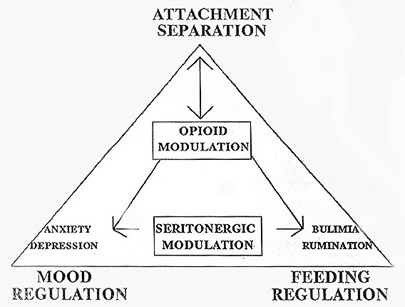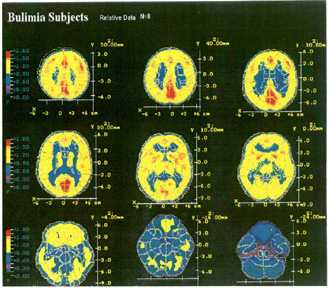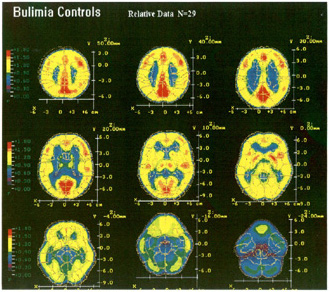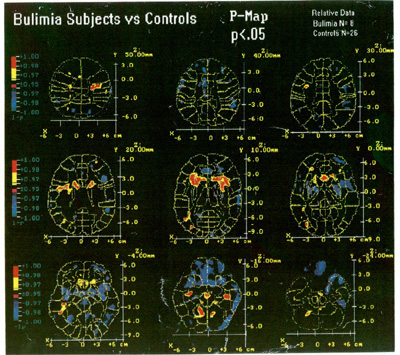SOCIETY OF BIOLOGICAL PSYCHIATRY
ANNUAL MEETING - 1996
A PET STUDY OF BULIMIA NERVOSA REVEALS CAUDATE HYPERMETABOLISM
EA, KLEIN; BJ BLINDER; JC, WU; JO, HAGMAN; MS, BUCHSBAUM
Brain Imaging Center, Department of Psychiatry
University of California at Irvine
Irvine, CA 92717
PURPOSE:
To reassess the brain metabolism of bulimic subjects
studied in prior research1 using statistical parametric
mapping with Monte Carlo simulation thresholding.
METHODS:
The brain metabolism of eight women with a history of
bulimia nervosa (28.62+/- 6.5 years) and twenty-nine
age and sex matched controls (28.57+/- 6.42 years) was
measured with positron emission tomography (PET) using
18F-fluorodeoxyglucose (FDG) as the radio-tracer during
a continuous performance uptake task. Group relative
average images were generated and subjected to a pixel
by pixel Student's test procedure to yield statistical
paramentric p-maps. These p-maps were then thresholded
using a Monte Carlo simulation. This analysis tool used
a normal control pool to generate a continuous cluster
size frequency distribution. P-map clusters smaller
than the critical size were discarded from analysis.
RESULTS:
Analysis revealed that bulimic individuals had higher
caudate metabolism across three PET slices at a significance
level of p<.01. Paradoxically, caudate metabolism
correlated inversely with the clinical pathology, measured
by EAT scores (p<.05). This finding is consistent
with the hypotheses that heightened alimentary ideation
is a compensatory mechanism which somehow counteracts
caudate hypermetabolism. Limbic metabolism in bulimic
groups was lower in deep orbital cortex and anterior
paracingulate (both p<.05) and higher in amygdala
and left anterior cingulate (both p<.01). These findings
suggest involvement of the caudate-orbitofrontal-cingulate
"worry circuit" in manner analogous to and
yet distinct from that seen in obsessive compulsive
disorder.
1 Wu, JC, Hagman, J, Buchsbaum, MS,
et al. Greater Left Cerebral Hemispheric Metabolism
in bulimia Assessed by Positron Emission Tomography.American
Journal of Psychiatry 1990; 147:309-312.
A PET STUDY OF BULIMIA NERVOSA REVEALS CAUDATE HYPERMETABOLISM
The purpose of this study was to reassess the brain
metabolism of bulimic subjects studied in prior research
(JC Wu et al Amer. Journ. Psychiatry 1990 147:309-312)
using statistical parametric mapping with Monte Carlo
simulation thresholding. The brain metabolism of eight
women with a history of bulimia nervosa (28.62+/- 6.5
years) and twenty-nine age and sex matched controls
(28.57+/- 6.42 years) was measured with positron emission
tomography (PET) using 18F-fluorodeoxyglucose (FDG)
as the radio-tracer during a continuous performance
uptake task. Group relative average images were generated
and subjected to a pixel by pixel Student's test procedure
to yield statistical paramentric p-maps. These p-maps
were then thresholded using a Monte Carlo simulation.
This analysis tool used a normal control pool to generate
a continuous cluster size frequency distribution. P-map
clusters smaller than the critical size were discarded
from analysis. Analysis revealed that bulimic individuals
had higher caudate metabolism across three PET slices
at a significance level of p<.01. Paradoxically,
caudate metabolism correlated inversely with the clinical
pathology measured by EAT scores (p<.05). This finding
is consistent with the hypotheses that heightened alimentary
ideation is a compensatory mechanism which somehow counteracts
caudate hypermetabolism. Limbic metabolism in bulimic
groups was lower in deep orbital cortex and anterior
paracingulate (both p<.05) and higher in the amygdala
and left anterior cingulate (both p<.01). These findings
suggest involvement of the caudate-orbitofrontal cingulate
"worry circuit" in a manner analogous to and
yet distinct from than seen in obsessive compulsive
disorder.




|


